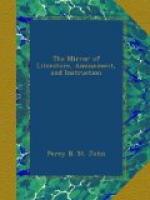The botanical garden of St. Petersburg, like all the rest of the institutions, is of gigantic dimensions. It contains sixty-five acres: a parallelogram formed by three parallel lines of hot-houses and conservatories, united at the extremities by covered corridors, constitutes the grand feature of this establishment. The south line contains green-house plants in the centre, and hot-house plants at each end; the middle line has hot-house plants only, and the north line is filled with green-house plants. The connecting corridors are two hundred and forty-five feet. The north and south line contain respectively five different compartments of one hundred toises each, that is to say, they are together six thousand feet. The middle line has seven compartments, that is, three thousand more, making in the whole length nine thousand feet!—Granville’s Travels.
* * * * *
THE HIRLAS HORN.
[Illustration: THE HIRLAS HORN.]
The engraving represents an elegant complimentary piece of plate, presented by the Committee for managing the Eisteddvod, held at Denbigh, September, 1828, to Dr. Jones, their Honorary Secretary, for his valuable services on that occasion.
Mr. Ellis, of John-street, Oxford-street, Medalist to the Royal Cambrian institution, was requested to execute (for this purpose) after his own design, a drinking goblet of an ancient form. Mr. E. thought of the Hirlas Horn, and he has completed a beautiful and unique piece of workmanship. It is an elegantly carved horn, about eighteen inches long, brilliantly polished, and richly mounted, the cover highly ornamented with chased oak leaves, and the tip adorned with an acorn; the horn resting on luxuriant branches of an oaken tree, exquisitely finished in chased silver. Around the cover is engraved the following inscription:—“Presented by the Cymmrodorion in Gwynedd, to RICHARD PHILLIPS JONES, M.D. for his unwearied exertions in promoting the Royal Eisteddvod, held at Denbigh, 1828.” The horn (the inside of which is lined with silver,) will contain about three half pints; and we doubt not that it will be often passed around, filled with Cwrw da, in remembrance of the interesting event which it is intended to commemorate—
“And former times renew in converse sweet.”
The origin of the Hirlas Horn is as follows:—
About 1160, Owain Cyveiliog, one of the most distinguished Princes of Powis, flourished; he was a great warrior and an eminent poet; several specimens of his writings are given in the Archaiology of Wales, published by the late patriotic Owain Jones Myfyr. His poem called the Hirlas Horn (the long blue horn,) is a masterpiece. It used to be the custom with the prince, when he had gained a battle, to call for the horn, filled with metheglin, or mead, and drink the contents at one draught, then sound it to show that there was no deception; each of his officers following his example. Mrs. Hemans has given a beautiful song, in Parry’s second volume of Welsh Melodies, on the subject, concluding thus:—




